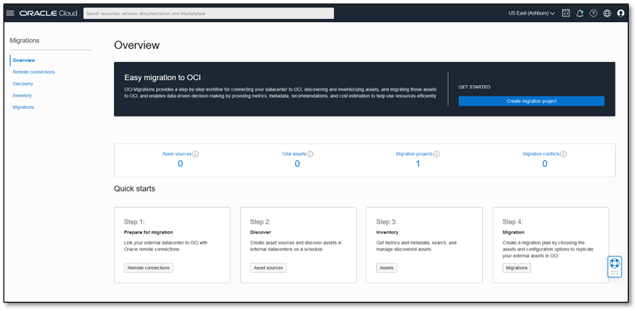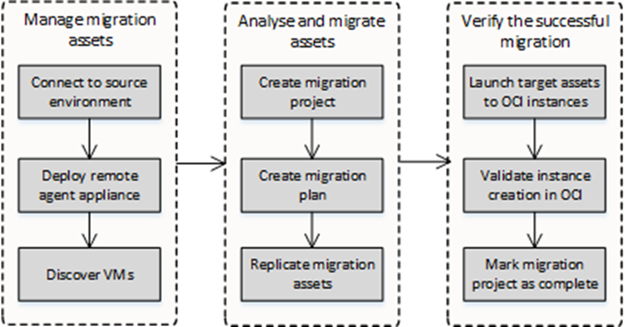Overview of Oracle Cloud Migration Service
By Hardik Desai, Director of Oracle Services
Oracle Cloud Migrations Service is a service that enables organizations to move their existing workloads easily and efficiently to the Oracle Cloud. The service offers a range of tools and resources to help organizations plan and execute their migrations, as well as ongoing support to help ensure the success of the migration.
The Oracle Cloud Migrations Service can be used to migrate a wide range of workloads to the Oracle Cloud. This includes:
Databases: The service provides tools and resources for migrating different types of databases, such as Oracle, SQL Server, MySQL, and PostgreSQL to the Oracle Cloud.
Applications: The service can be used to migrate a wide range of applications, including custom-built applications, packaged software, and open-source software.
Infrastructure: The service provides tools and resources for migrating virtual machines (VMs) and other types of infrastructure, such as storage and networking, to the Oracle Cloud.
Big Data and Analytics: The service can be used to migrate big data and analytics workloads, such as Hadoop and Spark clusters, to the Oracle Cloud.
Containers: The service can be used to migrate container-based workloads, such as those built using Docker and Kubernetes, to the Oracle Cloud.
Machine Learning: The service can be used to migrate machine learning workloads, such as those built using TensorFlow and PyTorch, to the Oracle Cloud.

Key Features
Automated Cloud Discovery (ACD)
The Automated Cloud Discovery (ACD) tool is a key feature of the Oracle Cloud Migrations Service. It is used to automatically discover and assess an organization’s existing workloads, providing detailed information on the resources and dependencies that need to be migrated.
The ACD tool uses a combination of agent-based and agentless discovery methods to collect data on the organization’s existing workloads. This data includes information on the operating system, software, and configurations of the workloads, as well as information on the resources and dependencies that are required to support them.
Once the data is collected, the ACD tool analyzes it to provide detailed information on the workloads that need to be migrated. This includes information on the resources and dependencies that need to be migrated, as well as information on any potential issues or challenges that may need to be addressed during the migration process.
The ACD tool also provides a detailed migration plan, which can be used to guide the migration process. The migration plan includes information on the steps that need to be taken to migrate the workloads, as well as information on the resources and dependencies that need to be migrated.
Detailed reports are provided by the tool on the migration plan and the status of the migration, which can be used to track the progress of the migration and ensure that it is completed successfully.
Cloud Adoption Framework (CAF)
The Cloud Adoption Framework (CAF) is a set of best practices, templates and guidelines that can be used to plan and execute the migration of workloads to the Oracle Cloud using the Oracle Cloud Migrations Service. The CAF provides a structured approach for migrating workloads to the cloud, covering all aspects of the migration process, from assessment to deployment and ongoing management.
The CAF provides guidance on how to plan and execute the migration, including how to identify the workloads that need to be migrated, how to assess the resources and dependencies required to support the workloads, and how to plan and execute the migration. It also provides guidance on how to deploy the workloads on the Oracle Cloud and how to manage and optimize the workloads after the migration is complete.
CAF includes a set of templates and guidelines that can be used to plan and execute the migration, including templates for creating a migration plan, templates for identifying and assessing workloads, and templates for deploying and managing workloads on the Oracle Cloud. It also provides a set of best practices for migrating workloads to the Oracle Cloud, including best practices for identifying and assessing workloads, best practices for planning and executing the migration, and best practices for deploying and managing workloads on the Oracle Cloud.
Guidance from the CAF also includes how to address common challenges and issues that may arise during the migration process, such as how to handle data privacy and security, how to handle compliance and regulatory requirements, and how to handle performance and scalability issues.
Migration Process Overview
The workflow of the migration process using the Oracle Cloud Migrations Service includes several key steps:
Assessment: The first step in the migration process is to assess the existing workloads that need to be migrated. The Automated Cloud Discovery (ACD) tool is used to automatically discover and assess the organization’s existing workloads, providing detailed information on the resources and dependencies that need to be migrated. This information is used to create a detailed migration plan, which can be used to guide the migration process.
Planning: Once the assessment is complete, the next step is to plan the migration. The Cloud Adoption Framework (CAF) is used to plan and execute the migration. It covers all aspects of the migration process, from assessment to deployment and ongoing management. The CAF provides best practices, templates, and guidelines to help organizations plan and execute their migrations.
Migration: After the planning is completed, the next step is to execute the migration. The Oracle Cloud Migrations Service provides a range of tools and resources for migrating different types of workloads. These include tools for migrating databases, applications, and infrastructure. For example, the service includes the Oracle Cloud Infrastructure Data Transfer Appliance for migrating large amounts of data to the cloud and the Oracle Cloud Infrastructure VM Import/Export for migrating virtual machines to the cloud.
Deployment: Once the migration is complete, the next step is to deploy the workloads on the Oracle Cloud. The Oracle Cloud Migrations Service provides resources and tools to help organizations deploy their workloads on the Oracle Cloud. This includes setting up the network, storage, and other resources, as well as configuring the workloads to use the same operating system and software as they did before the migration.
Ongoing Management: After the workloads are deployed on the Oracle Cloud, ongoing management is required to ensure the success of the migration. The Oracle Cloud Migrations Service provides ongoing support to help organizations manage and optimize their workloads on the Oracle Cloud. This includes monitoring and troubleshooting, as well as providing guidance and best practices for ongoing management.

It’s important to note that the migration process is not a one-time event, it requires a continuous effort to ensure that the workloads continue to run smoothly on the Oracle Cloud. The Oracle Cloud Migrations Service provides the necessary resources, tools, and support to make this possible.
Pricing and Licensing Information
The pricing for the Oracle Cloud Migrations Service is based on the number of assets and data that are being migrated. It’s important to note that the cost of migration also includes ongoing costs such as compute and storage costs for running the workloads on the Oracle Cloud.
When it comes to licensing considerations, it’s important to ensure that the necessary licenses for the software running on the workloads that are being migrated are in place. Organizations must also understand the licensing terms and conditions of the Oracle Cloud. For Oracle software running on the workloads, the appropriate licenses must be purchased for use on the Oracle Cloud. Oracle provides different licensing options for running Oracle software on the cloud, such as Bring Your Own License (BYOL) or License Included (LI).
Conclusion
In conclusion, Oracle Cloud Migrations Service is a powerful tool that allows organizations to move their existing workloads easily and efficiently to the Oracle Cloud. The service includes a range of tools and resources, such as Automated Cloud Discovery (ACD) and Cloud Adoption Framework (CAF), to help plan and execute migrations. The pricing is based on the number of assets and data that are being migrated and the ongoing costs such as compute and storage costs for running the workloads on the Oracle Cloud. It’s important to consider licensing implications and ensure the necessary licenses for the software running on the workloads that are being migrated are in place.
Contact Hardik or another member of our Oracle team using the below form. We look forward to speaking with you!

